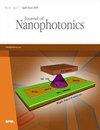作为可调横向反射移位器的过渡金属二硫化物/石墨烯夹层异质结构
IF 1.1
4区 物理与天体物理
Q4 NANOSCIENCE & NANOTECHNOLOGY
引用次数: 0
摘要
摘要纳米技术的出现导致了光电子器件小型化的必然需求。为了实现这一目标,必须开发具有低厚度、导电性和透明度以及更大活性区域的材料。实验证明,过渡金属二硫属化合物(TMD)/石墨烯组合的光电性质是高度可调的。另一方面,光从界面反射时的一个显著特征是其空间位移和角位移。入射平面中的“横向偏移”,即Goos–Hanchen(GH)偏移,由于其广泛的应用,引起了研究人员的极大兴趣。在我们的工作中,提出了一种原子薄的TMD/石墨烯/TMD三明治异质结构,并研究了其空间和角度GH位移。理论分析包括各种TMD材料,如MoSe2、MoS2、WSe2和WS2。对对称和非对称结构中波长、偏振、入射角和TMD层数的影响的详细研究表明,这种杂化物可以作为光学器件中的超薄宽带可调谐传感器。本文章由计算机程序翻译,如有差异,请以英文原文为准。
Sandwich heterostructure of transition metal dichalcogenide/graphene as tunable lateral reflection shifter
Abstract. The advent of nanotechnology has led to the inevitable need for miniaturization in optoelectronic devices. To achieve this goal, materials with low thickness, conductivity, and transparency, as well as a larger active area, must be developed. Experiments have proven that the opto-electrical properties of transition metal dichalcogenides (TMD)/graphene combinations are highly tunable. On the other hand, a notable feature of light when reflecting from an interface is its spatial and angular displacements. The “lateral shift” in the incident plane, referred to as the Goos–Hanchen (GH) shift, has garnered significant interest among researchers owing to its extensive range of applications. In our work, an atomically thin TMD/graphene/TMD sandwich heterostructure is proposed, and its spatial and angular GH shifts are investigated. The theoretical analysis includes various TMD materials such as MoSe2, MoS2, WSe2, and WS2. A detailed study of the effects of wavelength, polarization, incident angle, and number of TMD layers in symmetric and asymmetric structures suggests that this hybrid can serve as an ultrathin broadband tunable sensor in optical devices.
求助全文
通过发布文献求助,成功后即可免费获取论文全文。
去求助
来源期刊

Journal of Nanophotonics
工程技术-光学
CiteScore
2.60
自引率
6.70%
发文量
42
审稿时长
3 months
期刊介绍:
The Journal of Nanophotonics publishes peer-reviewed papers focusing on the fabrication and application of nanostructures that facilitate the generation, propagation, manipulation, and detection of light from the infrared to the ultraviolet regimes.
 求助内容:
求助内容: 应助结果提醒方式:
应助结果提醒方式:


